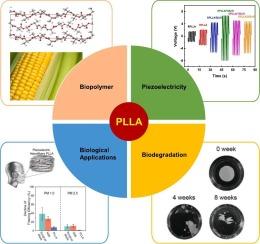用于下一代能量采集和生物医学应用的压电聚左旋乳酸
IF 13.2
1区 工程技术
Q1 ENGINEERING, CHEMICAL
引用次数: 0
摘要
聚l -乳酸(PLLA)作为一种压电高分子材料,由于其生物可降解性、生物相容性和剪切压电特性而受到越来越多的关注,使其成为自供电传感器、生物医学设备和下一代柔性电子等各种应用的有前途的候选者。本文综述了聚乳酸及其复合材料压电性能的最新研究进展,重点介绍了从分子取向、结晶度优化、纳米结构构建和复合材料工程等方面提高聚乳酸及其复合材料压电性能的策略。介绍了静电纺丝、热拉伸、溶剂铸造、3D打印、模板渗透和熔融纺丝等加工技术,以及它们对分子取向、晶相和压电输出的影响。此外,我们强调了pla基压电材料的降解行为,并讨论了其在能量收集,医疗健康和体内验证方面的应用。最后,本工作介绍了基于PLLA的高性能环保压电系统的设计和制备的当前挑战和未来方向。本文章由计算机程序翻译,如有差异,请以英文原文为准。


Piezoelectric poly-L-lactic acid for next-generation energy harvesting and biomedical applications
Poly-L-lactic acid (PLLA) has attracted increasing attention as a piezoelectric polymer material due to its biodegradability, biocompatibility and shear piezoelectric properties, making it a promising candidate for various applications like self-powered sensors, biomedical devices and next generation flexible electronics. Herein, this work summarizes the latest research progress on the piezoelectric performance of PLLA and its composites, focusing on the strategies for improving piezoelectric properties through molecular orientation, crystallinity optimization, nanostructure construction and composite engineering. Processing techniques such as electrospinning, hot stretching, solvent casting, 3D printing, template infiltrating and melt spinning are introduced, and how they affect molecular orientation, crystal phase as well as piezoelectric output. In addition, we emphasize degradation behavior of PLLA-based piezoelectric materials, and we also discuss their applications in energy harvesting, medical health and in vivo validation. Finally, this work introduces the current challenges and future directions for the design and preparation of high-performance and environmentally friendly piezoelectric systems based on PLLA.
求助全文
通过发布文献求助,成功后即可免费获取论文全文。
去求助
来源期刊

Chemical Engineering Journal
工程技术-工程:化工
CiteScore
21.70
自引率
9.30%
发文量
6781
审稿时长
2.4 months
期刊介绍:
The Chemical Engineering Journal is an international research journal that invites contributions of original and novel fundamental research. It aims to provide an international platform for presenting original fundamental research, interpretative reviews, and discussions on new developments in chemical engineering. The journal welcomes papers that describe novel theory and its practical application, as well as those that demonstrate the transfer of techniques from other disciplines. It also welcomes reports on carefully conducted experimental work that is soundly interpreted. The main focus of the journal is on original and rigorous research results that have broad significance. The Catalysis section within the Chemical Engineering Journal focuses specifically on Experimental and Theoretical studies in the fields of heterogeneous catalysis, molecular catalysis, and biocatalysis. These studies have industrial impact on various sectors such as chemicals, energy, materials, foods, healthcare, and environmental protection.
 求助内容:
求助内容: 应助结果提醒方式:
应助结果提醒方式:


